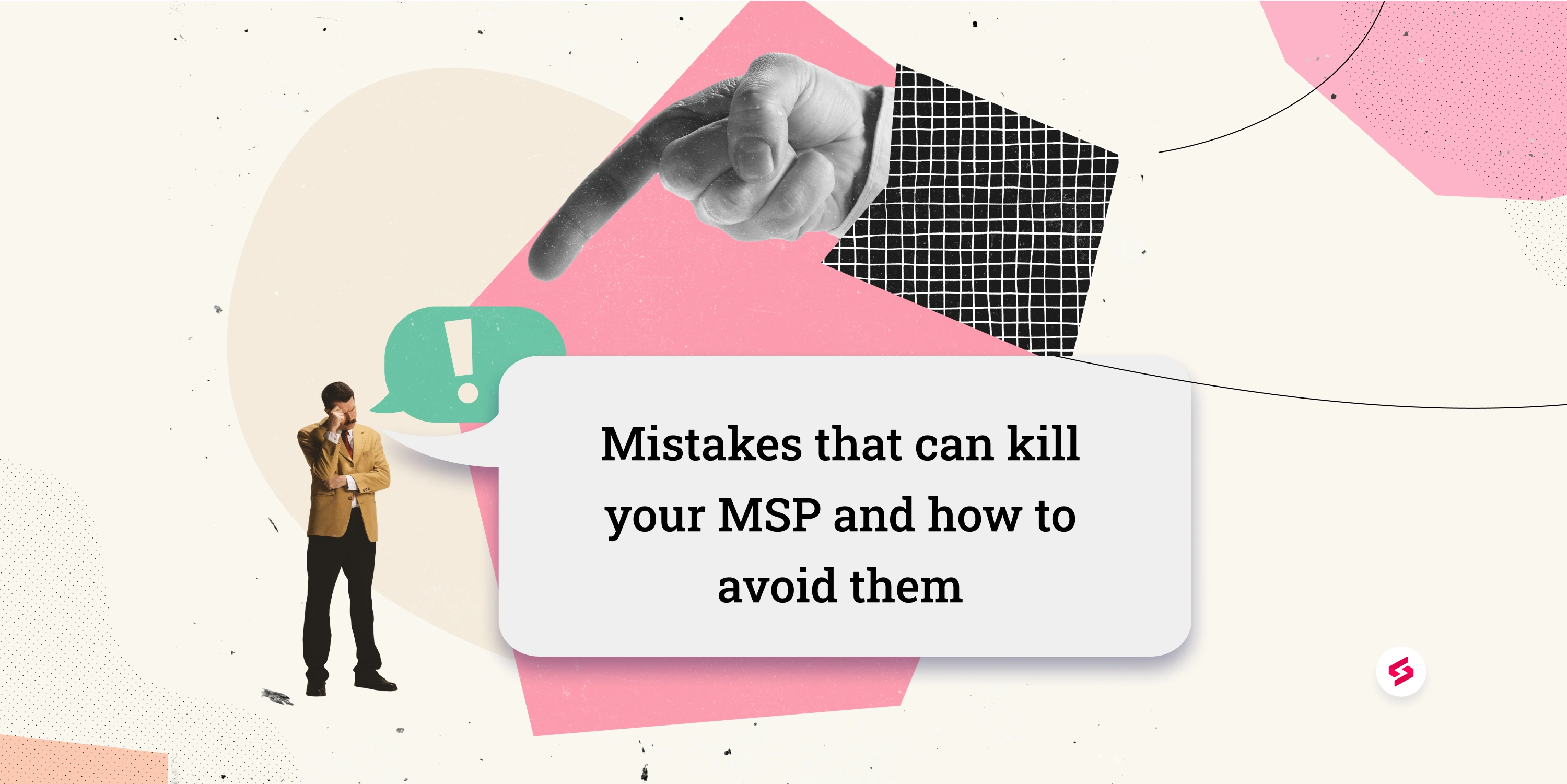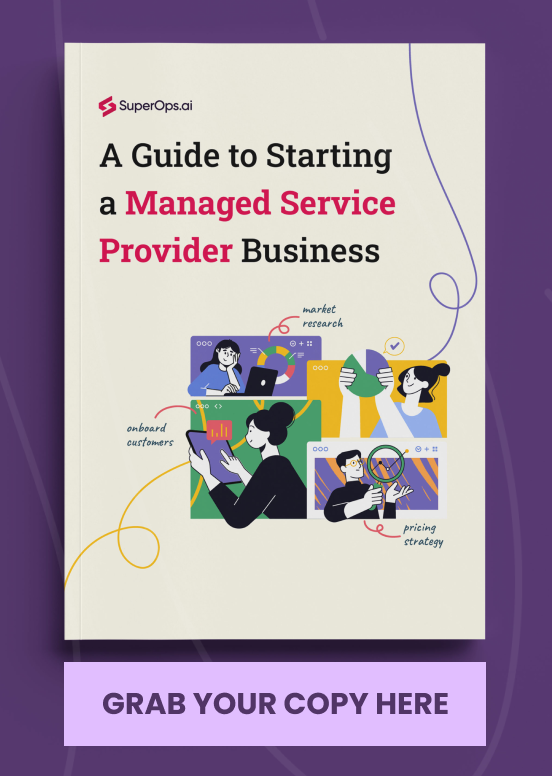There are mistakes you can sweep under the rug and there are mistakes that pull the rug from under you.
Building and running an MSP business can be tricky. It’s even trickier when you don’t pay attention to the little things that may be killing your business. Research by the U.S. Bureau of Labor Statistics (BLS) reveals that approximately 20% of small businesses fail within the first year, and the 45% that survived failed within the next five years.
But let’s back up a little bit. Starting up is risky. Some will fail no matter what. Maybe they had the wrong team. Maybe they didn’t maintain a steady cash flow. Maybe they grew faster than they should’ve.
What’s important is, these are mistakes they could’ve easily avoided if they had learned from MSPs that failed or if they’d listened to experts who know the nuances of the industry. Good thing is you don’t have to go searching for them - I have compiled a few for starters.
So let’s dive in, we have a not-to-do list to uncover today.
1. No backups
Well, not no backups. Every MSP has backups. This is just a reminder for MSPs who don’t take backups seriously or MSPs who reply with a blank stare when asked “when was the last time you verified if your backup works fine” or “Did you fix the backup drive that you mentioned failed in 2007?” There are a lot of ways to mess up a backup solution for a client.
Mike Herrington, VP of Sales and Marketing at i.t.NOW, says “Many MSPs have been fired because the backup solution they touted and sold failed when it mattered most. Don’t let that be you.”
Most backup mess-ups arise from setting and forgetting to check if the backups are “backing up”, not taking offsite copies, not conducting recovery testing, and not educating clients who are not ready to adopt your backup services and insist on using their existing backups you have little control over. Make sure whenever you onboard a client, you come up with an elaborate plan to check, test, and future-proof their backups to cover all the bases.
2. Not firing bad clients
If you still believe in the old adage “the customer is always right”, you need a new adage. Most people find it hard to let clients go. Well, who in their right mind asks a customer to leave? And lose the money? No way. But what if a client makes exorbitant demands? We’ve seen some MSPs going out of their way to meet the demands of their client, take on projects that are out of their scope, and cling on to clients who never take their advice and get themselves into problems regularly.
Those clients, you shouldn’t just drop. You should drop them like a hot plate.
Those clients are costing you more than they are paying.
Imagine a client wants to stick to their ancient antivirus systems and doesn’t take your inputs for upgrading. Yes, you can still keep them. Just be prepared to hear a lot of “You let us get hacked”, “How could you not have seen this coming”. They’re not going to say “We should’ve listened to you”.
So, next time you come across clients who’re more trouble than they’re worth, have a conversation with them. Most relationships are salvageable. If their cost-to-company is high, set up a review, and go through their accounts with them. Not taking your advice? Explain what the consequences might be. They have grown to a point you don’t have the capacity or business model to support? Well, you have to let them go. But diplomatically.
You don’t want to burn bridges with a client.
3. Not planning the scope of work
Taking on a project without a scope of work is a recipe for disaster. You may start without having enough information about the requirements, may overestimate or underestimate the outcome that needs to be achieved, take longer than expected, or spend more than the client wants you to. If you have a scope of work, you will have all the necessary steps laid out before you start working. Get proper alignment on the idea with the client. Send a quote. Take an advance if the outlay is too huge. Most importantly, set the expectations right.
Most importantly, make sure you have the proper scope of work laid out before you take up a project. Not after you’ve squandered a lot of time, labor, and money convincing the client you have delivered what was promised.
4. Billing fails
Here’s a worrisome scenario. Your technicians put hours into resolving a ticket, get interrupted with another priority issue, and forget to add a time entry. Or they can’t remember the specifics. All of these could lead to faulty billing, hence faulty payments, and hence faulty cash flow.
And that may not be all.
You could be sending monthly invoices late or in an irregular fashion. You could be reserved in following up on late payments. You’re not a lot of incorrect invoices, late payments, and forgotten time entries away from finding yourself strapped for cash. Cash flow predictability is critical for any business to survive, more so for MSP businesses, so ensure your billing system is top-notch. Get a PSA with an auto-timer that starts tracking time the moment a technician clicks on a ticket. Set up reminders to follow up on late payments.
Get the cha-chings right. Your business clings on the cha-chings.
5. Not taking upfront payments for larger outlays
Or for any outlay that requires you to wait for the client's approval with your fingers crossed lest you’re short of cash until things are sorted out. Whenever you buy hardware for a client on request or for a project, make sure you bill the client as soon as your supplier sends an invoice. Or, send a quote to the client and get approval beforehand.
Take a pledge, and that is to not to sign a big cheque or crack open the box of a procured item before you’re paid for it.
Always, always get paid upfront for any non-time entity your contract hasn’t covered already.
6. “Winging it” with your tech stack
There are MSPs who get by with remote access tools instead of an RMM, emails instead of a ticketing system, and spreadsheets instead of a documentation tool.
Getting a well-rounded tech stack is never an overkill, even if you’re just starting out. It is easy to set up a workflow or set up your business processes when you’re a smaller team. As an MSP, you’re not just fixing things. You have to fix things efficiently. You have to be proactive. You have to be analytical. The margin for error is less, because errors don’t just cost you time, anymore. They can cost you business. You’re running a business now. Run it like it’s supposed to be run.
So avoid the world of pain awaiting you. Get a simple, easy-to-manage, and affordable MSP platform. It’s not just necessary, it’s critical.
The last mistake
The smallest mistakes can snowball into catastrophic events if you don’t course correct until it’s too late. Good thing is it’s not hard. Fire that toxic client. Follow up on those missing payments. Expand your business because you’re ready, not because everyone else is doing it.
And there’s one more mistake many MSPs make.
Quitting too early.
You’re probably not where you want to be right now or where you imagined you’d be. Hold that thought. Maybe stick around a little longer. There might be an easy way you just haven’t found out yet.






